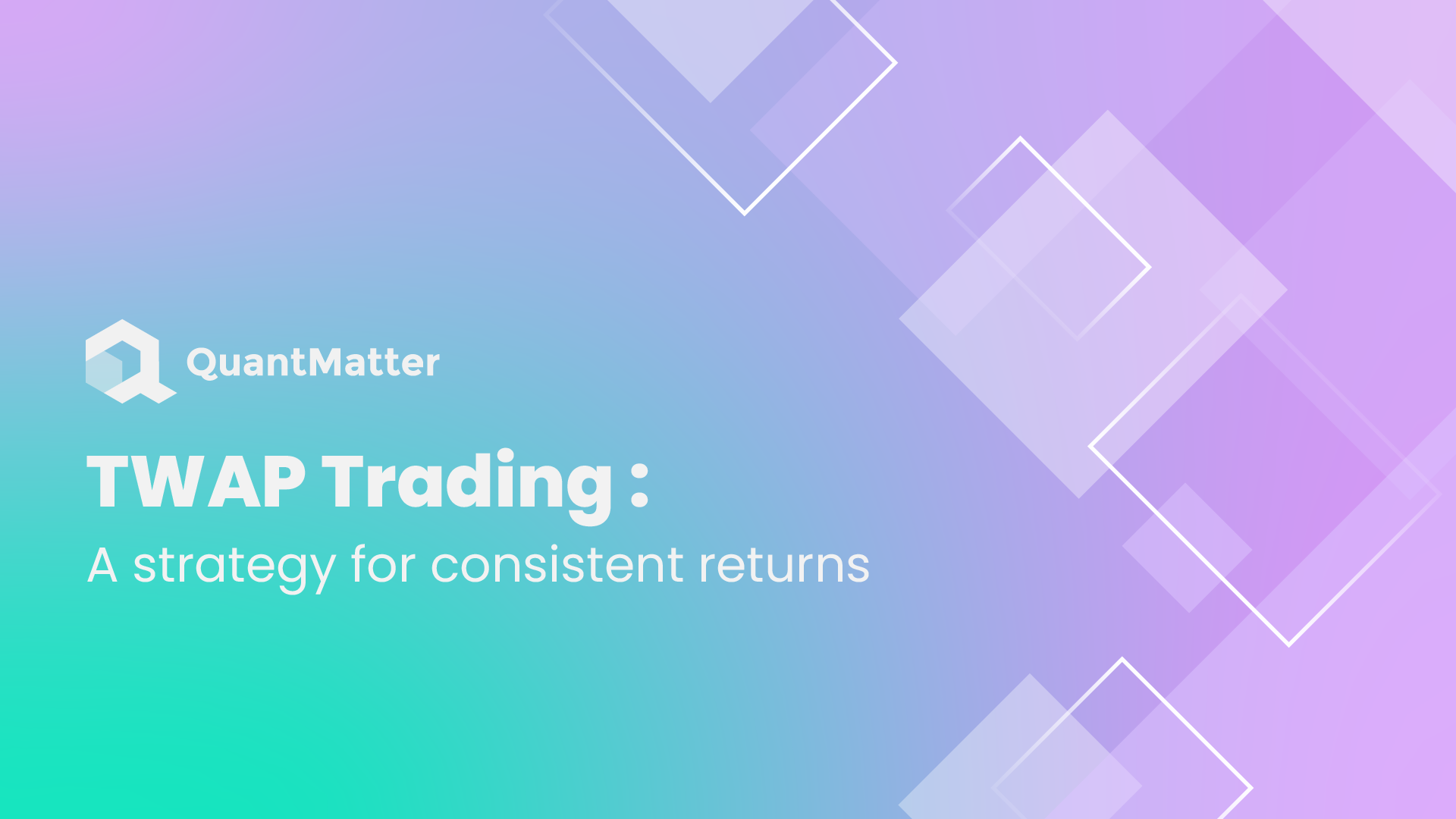
Algorithmic trading has become an integral part of the financial markets, enabling traders to execute orders efficiently and profitably. Among the various algorithmic trading strategies, Time-Weighted Average Price (TWAP) trading stands out as a method that aims for consistent execution while minimizing market impact.
Time-Weighted Average Price (TWAP) is a widely recognized trading algorithm that utilizes a time-based criterion to calculate a weighted average price. It is primarily used for the execution of large trade orders. In this article, we will delve into the concept of TWAP trading, how it works, its advantages, and some strategy tips for traders looking to implement this strategy effectively.
Understanding TWAP Trading

TWAP, which stands for Time-Weighted Average Price, is a trading strategy used in financial markets, particularly algorithmic trading. The primary goal of TWAP trading is to execute a large order while minimizing its impact on the market and achieving an average price that closely matches the prevailing market price over a specified time period.
TWAP is a widely used execution algorithm designed to distribute a trader’s order evenly over a specified time horizon. The primary objective of TWAP trading is to minimize the impact of a large order on the market by executing it gradually rather than all at once. This strategy is particularly useful because it ensures that the order doesn’t disrupt the prevailing market prices.
Also Read: All About Algorithmic Trading That You Should Know!
The benefits of TWAP trading include reducing market impact, achieving a consistent execution rate, minimizing timing risk, and providing flexibility for traders with different objectives. It is often used by institutional investors and traders handling large orders to ensure that their trades do not significantly influence market prices.
However, traders using TWAP should be aware of potential slippage, where the executed price may deviate slightly from the prevailing market price due to market fluctuations. Additionally, TWAP is more effective in liquid markets, and traders should consider market conditions and adapt their strategies accordingly.
How Does TWAP Trading Work?

TWAP trading is a strategy designed to execute large orders in a way that minimizes their impact on market prices. It offers traders a systematic approach to achieving average prices close to market rates over a specified time frame, making it a valuable tool in algorithmic trading. However, how does TWAP trading actually work?
1. Time Horizon Selection
The first step in TWAP trading is to choose a time horizon over which you want to execute your order. This can be an hour, a day, or any other duration that suits your trading goals. Time horizon selection in TWAP trading is a critical decision that impacts how a large order is executed.
Traders should carefully consider their objectives, market conditions, and the nature of the asset to determine the most suitable time frame. This decision-making process is essential for achieving the desired balance between minimizing market impact and achieving the best possible average price over the chosen duration.
2. Order Slicing
Order slicing in TWAP trading is a strategy that involves breaking down a large order into smaller, regularly executed portions over a specified time horizon. This approach allows traders to achieve consistent execution, reduce market impact, and effectively manage the risk associated with executing large orders in financial markets. Once the time horizon is defined, the order is sliced into smaller, equal-sized chunks. These smaller orders are then executed at regular intervals throughout the chosen time frame.
3. Consistent Execution
TWAP aims to execute orders consistently throughout the trading period, regardless of market fluctuations. This means that if the market is volatile, the algorithm will adjust the size of the orders to maintain a consistent pace.
Consistent execution is a core principle in TWAP trading that revolves around executing orders at a steady and uniform pace over a specified time horizon. This approach seeks to minimize market impact, maintain market neutrality, and align with the trader’s objectives while adapting to changing market conditions when necessary. It’s a strategy used to achieve reliable and controlled execution in financial markets.
4. Adaptability
Adaptability is a critical feature in TWAP trading that enables the algorithm or trader to respond dynamically to changing market conditions. By adjusting execution parameters such as order size and rate, the strategy seeks to optimize execution efficiency while minimizing market impact. This adaptability is essential for achieving consistent and reliable results in various market environments.
Some TWAP algorithms are adaptive, meaning they can adjust the execution rate based on market conditions. For example, during high volatility, the algorithm may slow down to avoid aggressive price movements
Strategy Tips for TWAP Trading for Consistent Returns

TWAP (Time-Weighted Average Price) is related to consistent returns due to its core objective of executing trades in a way that minimizes market impact and achieves an average price that closely aligns with prevailing market rates over a specified time period. To effectively implement TWAP trading, consider these strategy tips:
1. Monitor Market Liquidity
Monitoring market liquidity is a crucial strategy tip in the context of TWAP (Time-Weighted Average Price) trading. Liquidity refers to the ease with which an asset can be bought or sold in the market without causing significant price movements. Assess the liquidity of the market you intend to trade in. TWAP is most effective in liquid markets with ample trading volume. In illiquid markets, consider alternative execution strategies.
2. Time of Day Matters
The time of day matters significantly in TWAP (Time-Weighted Average Price) trading, as it can influence market conditions, liquidity, and the effectiveness of the trading strategy. Traders should carefully consider how it aligns with their trading objectives, risk tolerance, and the specific assets they are trading.
Be mindful of the time of day when implementing TWAP. Different trading hours can exhibit varying levels of volatility and liquidity. Adjust your strategy accordingly.
3. Pause During Major Events
Pausing During Major Events is an important strategy tip for TWAP (Time-Weighted Average Price) trading. This tip suggests that traders should be prepared to temporarily halt or adjust their TWAP trading strategy in response to significant market events or unexpected news releases.
Unexpected news or events can disrupt TWAP strategies. Have mechanisms in place to pause or adapt your TWAP orders in response to significant market developments.
Also Read: 5 Best Liquidity Trackers in the Market (September 2023)
4. Optimize Time Horizon
Optimizing the Time Horizon is a strategy tip in TWAP (Time-Weighted Average Price) trading that involves carefully selecting the most suitable duration over which to execute a large order.
Experiment with different time horizons to find the optimal balance between minimizing market impact and achieving your trading goals. Shorter time horizons may be suitable for smaller orders, while longer horizons may be better for larger ones.
5. Use Risk Management
Use Risk Management is a critical strategy tip in TWAP (Time-Weighted Average Price) trading and refers to the practice of implementing risk management measures to protect a trader’s capital and manage potential losses. Employ effective risk management strategies alongside TWAP trading. Set stop-loss orders or price limits to protect your positions from adverse market movements.
6. Cost Considerations
Algorithmic trading services, including TWAP, come with associated costs. Cost Considerations in the context of TWAP (Time-Weighted Average Price) trading refer to the careful evaluation and management of various expenses and factors that can impact the overall cost of executing trades using this strategy.
Cost considerations are a critical aspect of TWAP trading that involves evaluating and managing the various expenses and factors that can affect the overall cost of executing trades. Effective cost management helps traders optimize their TWAP strategy, enhance profitability, and align their trading goals with the financial resources they allocate to their trades.
Conclusion
TWAP trading is a valuable tool in the arsenal of algorithmic traders, offering a methodical approach to executing large orders while minimizing market impact. By spreading orders evenly over a chosen time horizon, TWAP can help traders achieve consistent results in various market conditions. However, it’s essential for traders to not only understand the intricacies of TWAP but also follow these strategy tips to tailor the strategy to their specific needs and market conditions.
TWAP helps traders achieve more predictable and consistent trading outcomes over time. This consistency is particularly valuable for institutional investors and traders dealing with large volumes of assets who seek to avoid undue market disruption and achieve their desired returns with reduced risk. With careful planning, execution, and risk management, TWAP trading can be a powerful tool for achieving trading goals in today’s financial markets.
Disclaimer: The information provided by Quant Matter in this article is intended for general informational purposes and does not reflect the company’s opinion. It is not intended as investment advice or a recommendation. Readers are strongly advised to conduct their own thorough research and consult with a qualified financial advisor before making any financial decisions.

I craft stories that make complex ideas clear. I simplify the blend of data science, machine learning, and crypto trading, showcasing how advanced tech and quantitative models analyze data for informed trading choices. Join me in exploring the realm of quantitative trading, where my narratives make intricate concepts easy to grasp.
- Alifia Berizkyhttps://quantmatter.com/author/alifia-berizky/
- Alifia Berizkyhttps://quantmatter.com/author/alifia-berizky/
- Alifia Berizkyhttps://quantmatter.com/author/alifia-berizky/
- Alifia Berizkyhttps://quantmatter.com/author/alifia-berizky/
